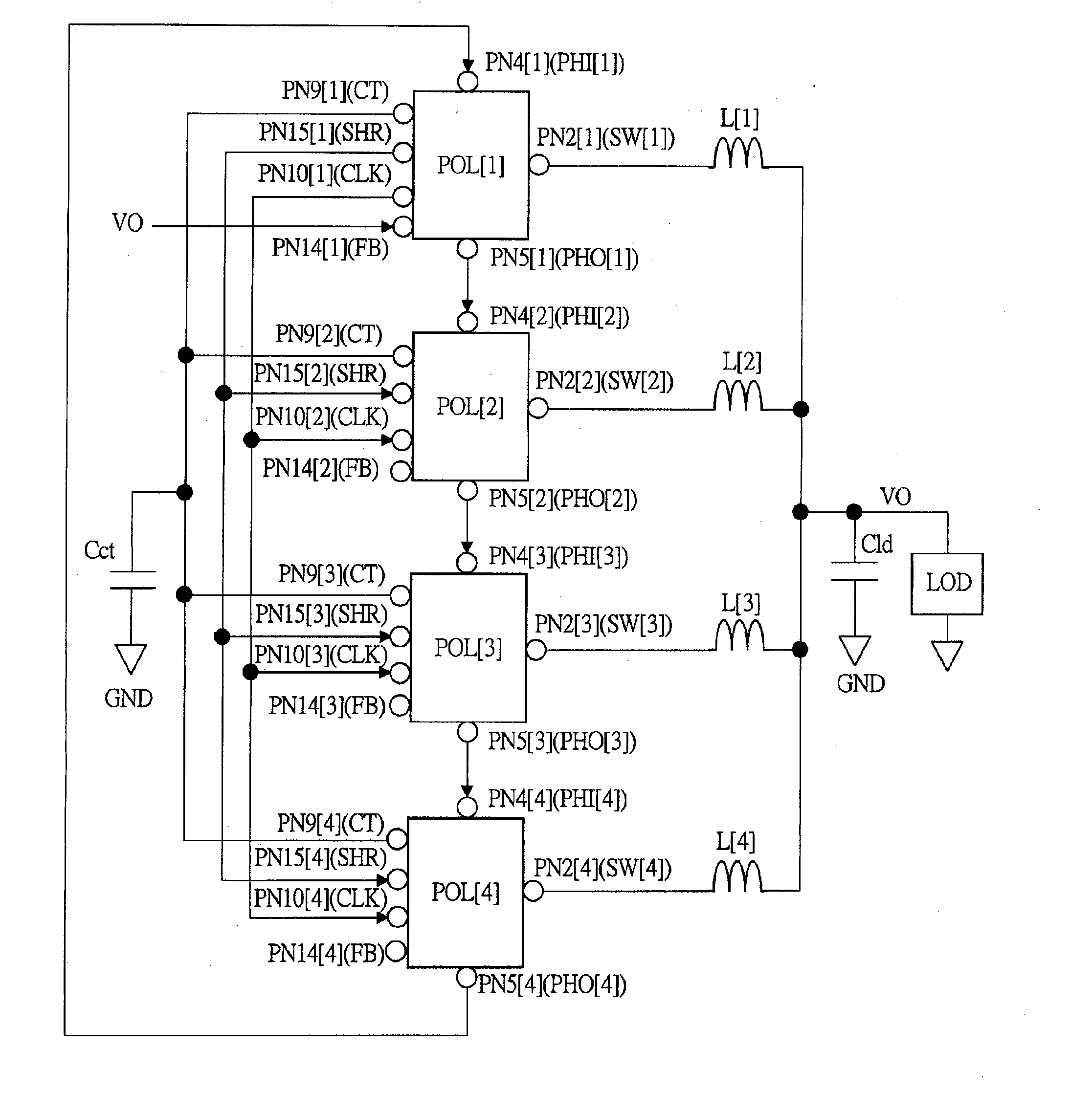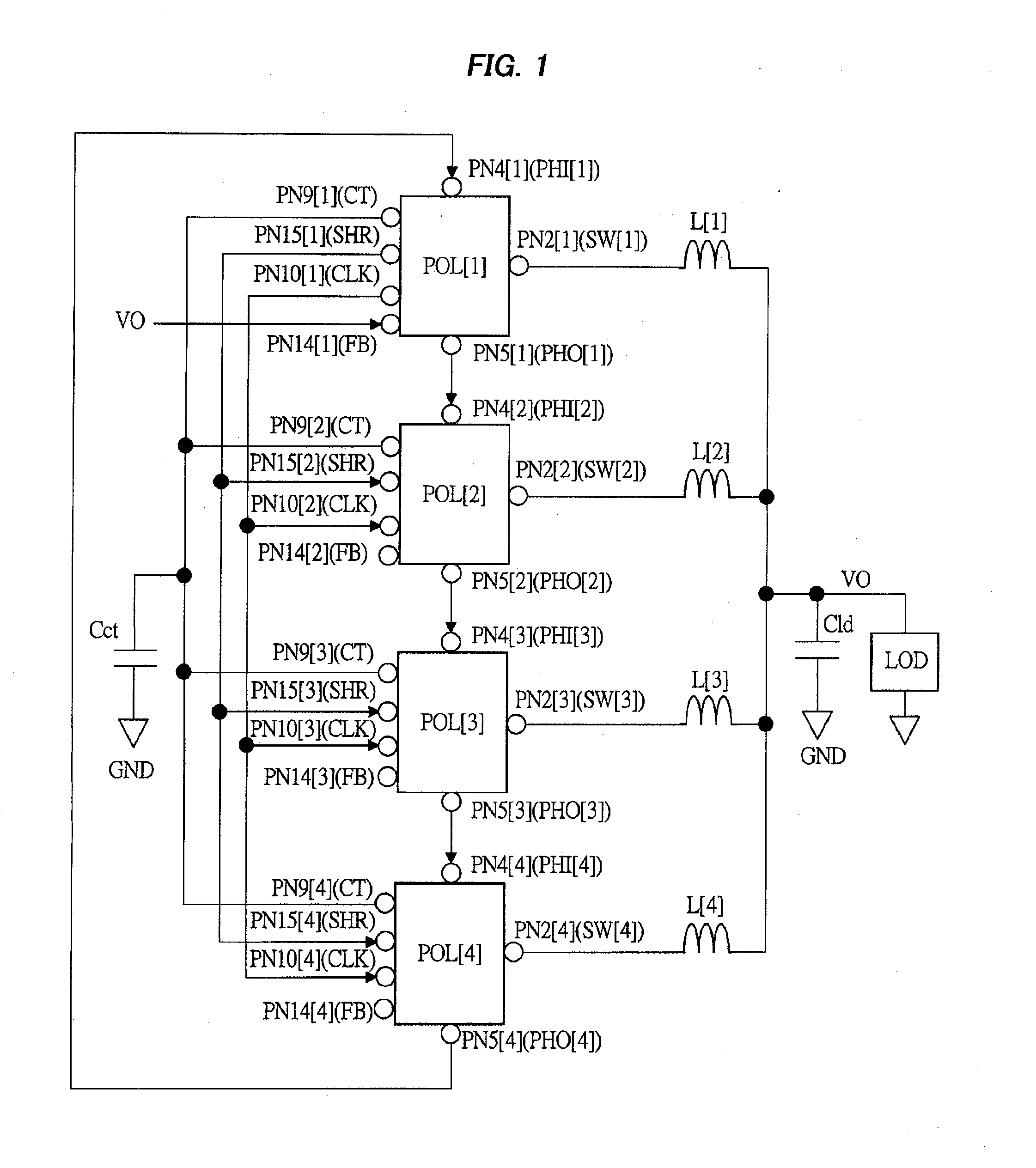Semiconductor device and power source device
a technology of semiconductor devices and power source devices, which is applied in the direction of electric variable regulation, process and machine control, instruments, etc., can solve the problems of environmental problems, increased leakage current, and increased consumption of various types of circuit units, so as to improve power conversion efficiency and be easily changed.
- Summary
- Abstract
- Description
- Claims
- Application Information
AI Technical Summary
Benefits of technology
Problems solved by technology
Method used
Image
Examples
embodiment 1
[0050]>
[0051]FIG. 1 is a block diagram showing an example of the outline configuration of a power source device according to Embodiment 1 of the present invention. The power source device shown in FIG. 1 comprises a plurality of (here, four) drive units (semiconductor devices) POL[1]-POL[4] and a plurality of inductors L[1]-L[4], and capacitors Cct, Cld. Each drive unit POL[n] (n=1-4) has an identical internal configuration, and includes seven external terminals PN2[n], PN4[n], PN5[n], PN9[n], PN10[n], PN14[n], and PN15[n]. POL[1] serves as a master drive unit, and POL[2]-POL[4] serve as a slave drive unit, respectively. One ends of L[1]-L[4] are commonly coupled to an output power source node VO, and the other ends of each L[n] are individually coupled to PN2[n], respectively. Cld is provided between VO and a ground power source voltage GND.
[0052]The external terminal PN9[n] of each POL[n] is commonly coupled to one end of the capacitor Cct, through which a clock control signal CT ...
embodiment 2
[0090]>
[0091]In Embodiment 2, a configuration example is described in which additional functions are added to the power source device described in FIG. 2 of Embodiment 1. FIG. 8 is a circuit block diagram showing an example of the detailed configuration of the main part in the power source device according to Embodiment 2 of the present invention. The power source device shown in FIG. 8 differs from the power source device of FIG. 2 in terms of the internal configuration of the oscillator circuit blocks OSC_BKb[1]-OSC_BKb[3] and phase signal generation circuit blocks PG_BKb[1]-PG_BKb[3] in each of the drive units POL[1]-POL[3]. Furthermore, each of enable signals EN[1]-EN[3] is input to each of the control logic circuits LGC[1]-LGC[3] in each of POL[1]-POL[3]. The detailed description of the other configuration is omitted because it is the same as that of the power source device of FIG. 2. When EN[n] is in an inactive state, each LGC[n] fixes the transistors QH[n], QL[n] to an off-s...
embodiment 3
[0104]>
[0105]In Embodiment 3, a configuration example is described in which additional functions are added to the power source device described in FIG. 8 of Embodiment 2. FIG. 10 is a circuit block diagram showing an example of the detailed configuration of a main part in a power source device according to Embodiment 3 of the present invention. The power source device shown in FIG. 10 includes external terminals PN11b[n], PN12[n], and an enable detection circuit ENDET[n] added to each drive unit POL[n] (n=1-3), as compared with the power source device of FIG. 8. The detailed description of the other configuration is omitted because it is the same as that of the power source device of FIG. 8.
[0106]>
[0107]FIG. 11 is a circuit diagram showing an example of the detailed configuration of the enable detection circuit ENDET in the power source device of FIG. 10. The enable detection circuit ENDET shown in FIG. 11 includes a comparator circuit CMP_EN receiving the common control signal SHR ...
PUM
| Property | Measurement | Unit |
|---|---|---|
| voltage | aaaaa | aaaaa |
| charge rate | aaaaa | aaaaa |
| voltage level | aaaaa | aaaaa |
Abstract
Description
Claims
Application Information
 Login to View More
Login to View More - R&D
- Intellectual Property
- Life Sciences
- Materials
- Tech Scout
- Unparalleled Data Quality
- Higher Quality Content
- 60% Fewer Hallucinations
Browse by: Latest US Patents, China's latest patents, Technical Efficacy Thesaurus, Application Domain, Technology Topic, Popular Technical Reports.
© 2025 PatSnap. All rights reserved.Legal|Privacy policy|Modern Slavery Act Transparency Statement|Sitemap|About US| Contact US: help@patsnap.com



